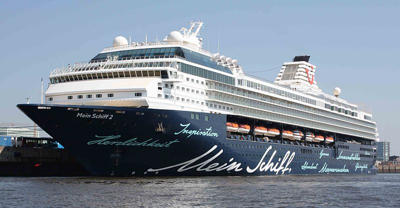TUI Cruises Implementing DataCore Software-Defined Storage
BSH IT Solutions implemented solution.
This is a Press Release edited by StorageNewsletter.com on June 20, 2017 at 2:14 pmDataCore Software Corporation announced that its platform, SANsymphony, has been implemented on the cruise ship fleet of TUI Cruises, a joint venture between German TUI AG and Royal Caribbean Cruises Ltd., the world’s second-largest cruise company.

The SANsymphony storage platform delivers highly available storage capacity for VMware, SQL Server and Exchange. DataCore partner BSH IT Solutions GmbH implemented the solution.
“DataCore’s scalability in terms of capacity, performance and functionality gives us the flexibility we need to respond to future challenges, whether it is on the single ships or for the entire fleet. In addition, SANsymphony has demonstrated total reliability. We plan to keep expanding our ‘Mein Schiff’ fleet, and we will continue to rely on BSH IT Solutions and SANsymphony to sail alongside,” said Matthias Fahrner, director IT competence center and strategy, TUI Cruises.
TUI Cruises offers exclusive routes along the Mediterranean coasts, Canary Islands, the Caribbean and Central America, the Baltic Sea, the Nordic region, Great Britain and Iceland. Other travel areas include the Arabian Gulf, Asia, and North America, departing from New York. The company started with the acquisition of Mein Schiff 1 in 2009 and Mein Schiff 6 will be launched in 2017. Two more new ships are already planned and are being manufactured through 2019 at the Meyer Turku shipyard in Finland.
The IT infrastructure for the first five members of the fleet was designed on land by DataCore partner BSH IT Solutions, a part of Allgeier SE, an IT service provider with more than 6,000 permanent employees and more than 90 locations in Europe, Asia and America. BSH IT Solutions implemented SANsymphony on board within narrow time frames, managing the platform remotely via its data centers in Germany.
Precise planning, preparation and implementation for each ship took about a year for each new construction project, from the first compatibility test ‘staging’ in Hamburg nine months before the launch, to second ‘staging’ in Turku (Finland) and ‘sea trials,’ to final implementation on board in the tight timeline when the ship is docked.
The entire IT infrastructure on the ships is designed redundantly. Systems are installed in separate fire and water zones, on different decks, and in the data centers located at the bow and stern.
SANsymphony synchronously mirrors data, regardless of the manufacturer, model or technology of the connected storage hardware (disk or SSD), in order to ensure a high availability for systems on the ships. While Mein Schiff 2 used an existing HP Bladecenter for the DataCore nodes, Mein Schiff 3 was equipped with a 10Gb FC infrastructure, new HP Proliant and HP disk shelf with SAS disk capacity of 20TB for each side. Mein Schiff 4 uses Dell PowerEdge and PowerVault extension for the DataCore nodes. DataCore’s hardware-agnostic approach means that new and existing storage hardware can be integrated, and its lifespan is extended.
If a section of a data center fails, the other side automatically takes over (transparent auto failover) and resyncs the system when it is restarted (auto failback). The storage environment of Mein Schiff 5 supports four VMware ESXi hosts as well as two Veeam Software, Inc. backup servers to backup the 50 VMs. Separately from the navigation infrastructure, these run all of the systems needed for the cruise, tourism and administrative operations. In particular, Exchange, SQL Server, file services and Active Directory play an important role.
“SANsymphony offers an outstanding price-performance ratio. The numerous integrated technologies helped us successfully migrate the data centers; they solve our current storage challenges and give us a high level of flexibility and investment security for the future,” said Matthias Fahrner.
Benefits at a glance:
- High level of availability thanks to synchronous mirroring
- Transparent failover
- Scalable in terms of capacity, output and performance
- Easy to use on site, with worldwide remote management by the partner












 Subscribe to our free daily newsletter
Subscribe to our free daily newsletter
